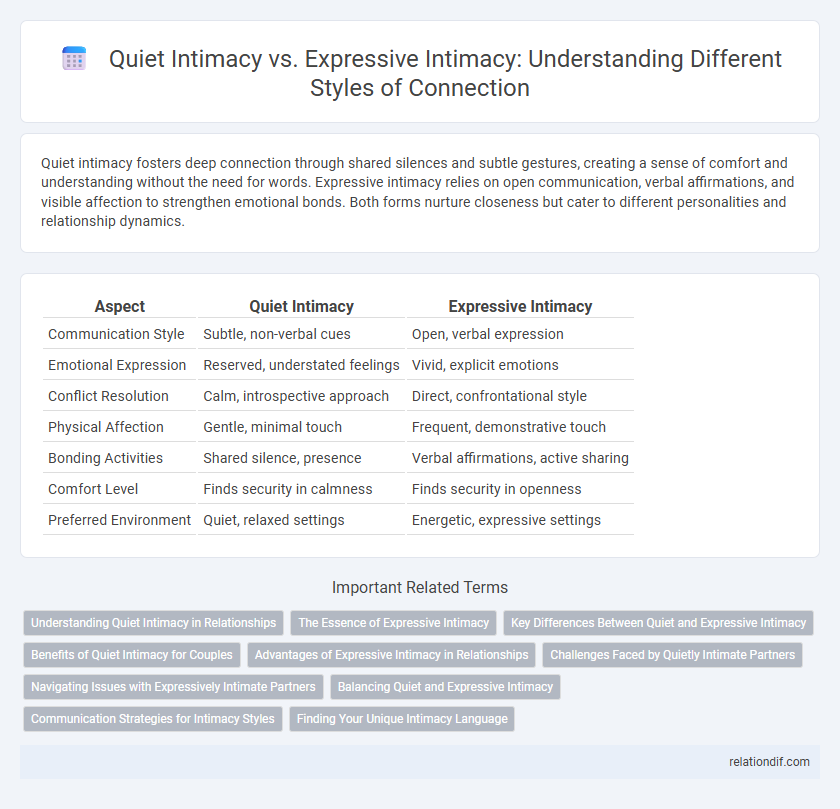Quiet intimacy fosters deep connection through shared silences and subtle gestures, creating a sense of comfort and understanding without the need for words. Expressive intimacy relies on open communication, verbal affirmations, and visible affection to strengthen emotional bonds. Both forms nurture closeness but cater to different personalities and relationship dynamics.
Table of Comparison
| Aspect | Quiet Intimacy | Expressive Intimacy |
|---|---|---|
| Communication Style | Subtle, non-verbal cues | Open, verbal expression |
| Emotional Expression | Reserved, understated feelings | Vivid, explicit emotions |
| Conflict Resolution | Calm, introspective approach | Direct, confrontational style |
| Physical Affection | Gentle, minimal touch | Frequent, demonstrative touch |
| Bonding Activities | Shared silence, presence | Verbal affirmations, active sharing |
| Comfort Level | Finds security in calmness | Finds security in openness |
| Preferred Environment | Quiet, relaxed settings | Energetic, expressive settings |
Understanding Quiet Intimacy in Relationships
Quiet intimacy in relationships emphasizes deep connection through nonverbal communication, shared presence, and mutual comfort without the need for constant verbal expression. Understanding quiet intimacy involves recognizing the power of subtle gestures, eye contact, and synchronized emotional states that foster trust and emotional security. Couples who cultivate quiet intimacy often experience a stable bond grounded in empathy, patience, and respectful attentiveness to each other's inner worlds.
The Essence of Expressive Intimacy
Expressive intimacy centers on open communication, emotional vulnerability, and shared experiences that cultivate deep connection and trust. It involves verbalizing feelings, desires, and needs, fostering closeness through transparency and active engagement. This form of intimacy strengthens relationships by encouraging authenticity and emotional reciprocity between partners.
Key Differences Between Quiet and Expressive Intimacy
Quiet intimacy is characterized by deep emotional connection through shared silence, subtle gestures, and mutual comfort without the need for constant verbal communication. Expressive intimacy involves open emotional disclosure, frequent verbal affirmations, and overt displays of affection that actively convey feelings and thoughts. The key differences center on communication style, with quiet intimacy emphasizing nonverbal understanding and expressive intimacy prioritizing vocal emotional exchange.
Benefits of Quiet Intimacy for Couples
Quiet intimacy fosters deep emotional connection by emphasizing nonverbal communication and shared presence, enhancing mutual understanding and trust. Couples experiencing quiet intimacy often report reduced stress levels and heightened feelings of safety, creating a stable foundation for relationship growth. This subtle, peaceful bond allows partners to feel valued and accepted without the pressure of constant verbal expression.
Advantages of Expressive Intimacy in Relationships
Expressive intimacy fosters open communication, allowing partners to share emotions and thoughts freely, which builds deeper trust and understanding. This openness promotes emotional vulnerability, strengthening the bond and enhancing relationship satisfaction. Couples practicing expressive intimacy often experience quicker conflict resolution and increased emotional support.
Challenges Faced by Quietly Intimate Partners
Quiet intimacy challenges partners to convey deep connection without frequent verbal affirmations, often leading to misinterpretations of emotional availability. Partners who prioritize nonverbal cues and subtle gestures may struggle with societal expectations favoring expressive displays of affection. The risk of feeling undervalued or misunderstood increases when external observers or even the partners themselves mistake quiet intimacy for emotional distance or lack of commitment.
Navigating Issues with Expressively Intimate Partners
Expressively intimate partners often communicate their emotions openly, which can facilitate deep connection but also lead to overwhelming interactions if boundaries are not respected. Navigating issues requires active listening, clear communication of personal limits, and mutual empathy to balance emotional expression with individual comfort. Establishing regular check-ins helps maintain harmony and prevents misunderstandings in relationships characterized by high emotional expressiveness.
Balancing Quiet and Expressive Intimacy
Balancing quiet and expressive intimacy involves recognizing the value of both silent connection and open emotional sharing in relationships. Quiet intimacy fosters deep understanding through subtle nonverbal cues and presence, while expressive intimacy strengthens bonds through verbal communication and emotional vulnerability. Achieving equilibrium between these forms nurtures trust, emotional safety, and lasting relational satisfaction.
Communication Strategies for Intimacy Styles
Quiet intimacy relies on nonverbal cues, shared silences, and subtle gestures to convey deep emotional connection, requiring partners to develop heightened sensitivity and patience in communication. Expressive intimacy involves openly sharing thoughts, feelings, and desires through verbal exchanges, enhancing emotional clarity and mutual understanding. Effective communication strategies for intimacy styles include active listening, validating emotions, and adapting interaction patterns to align with each partner's comfort level in expressing intimacy.
Finding Your Unique Intimacy Language
Quiet intimacy thrives in shared moments of silence and subtle gestures that communicate deep understanding, while expressive intimacy relies on verbal affirmations and open emotional exchanges to build connection. Identifying whether you resonate more with quiet or expressive intimacy allows you to tailor your relationship behaviors to foster genuine closeness and trust. Recognizing and respecting these unique intimacy languages supports healthier communication and stronger emotional bonds in partnerships.
Quiet intimacy vs expressive intimacy Infographic

 relationdif.com
relationdif.com